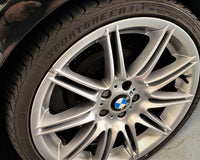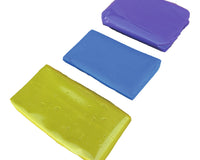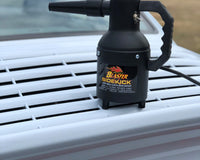When it comes to maintaining the appearance of your vehicle and protecting its paintwork, there are various options available. Two popular choices are paint correction and ceramic coating. While both techniques aim to enhance the appearance and protect the paint, they differ significantly in terms of their purpose, application, and benefits. Let’s have a look at the 10 key differences between paint correction and ceramic coating.
Purpose
Paint correction is a meticulous process focused on restoring the appearance of your vehicle's paintwork. Over time, the paint can develop imperfections like swirl marks, scratches, water spots, and oxidation, which can diminish its overall look. Paint correction involves using specialized tools and techniques to remove these imperfections and restore the paint to its original condition. It aims to achieve a smooth, glossy finish and enhance the clarity and depth of the paint.
Ceramic coating, on the other hand, is primarily designed to provide long-term protection for your vehicle's paint. It is a liquid polymer that chemically bonds with the paint surface, forming a durable and protective layer. The coating creates a shield against environmental contaminants such as dirt, dust, bird droppings, tree sap, and UV rays. Additionally, ceramic coatings offer hydrophobic properties, meaning water and other liquids bead up and roll off the surface easily, making the vehicle easier to clean.
Application Process
Paint correction involves a multi-step process that requires attention to detail and expertise. It begins with a thorough cleaning of the vehicle's surface to remove dirt and debris. Then, abrasive compounds and polishing machines are used to carefully work on the paint, gradually eliminating imperfections. The process typically includes compounding (using a cutting compound to remove deeper defects), polishing (refining the paint to remove smaller imperfections), and refining (further enhancing the clarity and gloss). The application of paint correction can take several hours or even days, depending on the condition of the paintwork.
The application process for ceramic coating is relatively straightforward, but it still requires proper preparation and care. The vehicle's paint must be thoroughly cleaned and decontaminated before the coating is applied. The ceramic coating is then spread evenly onto the surface using an applicator pad or by hand. After application, the coating needs to cure for a specific period, typically 24-48 hours, to ensure it fully bonds with the paint and becomes effective. It is essential to avoid exposing the vehicle to water or other liquids during the curing process. Once cured, the ceramic coating forms a protective layer on the paint surface.
Results
The primary objective of paint correction is to eliminate imperfections and restore the paintwork to its original state. The process can effectively remove swirl marks, light scratches, water spots, and other minor defects, resulting in a highly reflective and glossy finish. Paint correction enhances the overall appearance of the paint by improving its clarity and depth. However, it is important to note that paint correction does not provide long-term protection against future damage. The corrected paint is still susceptible to environmental contaminants and requires regular maintenance to retain its appearance.
Ceramic coatings offer a range of benefits beyond just enhancing the appearance of the paint. Once applied and fully cured, ceramic coatings create a semi-permanent layer on the paint surface. This layer acts as a sacrificial barrier, protecting the underlying paint from various contaminants, UV rays, oxidation, and chemical stains. The coating adds depth and gloss to the paint, making it look more vibrant and reflective. Furthermore, ceramic coatings have hydrophobic properties, which means they repel water and contaminants, making the vehicle easier to clean and maintain.
Protection
While paint correction aims to restore the appearance of the paint, it does not provide long-term protection against future damage. In the process of correcting imperfections, a thin layer of the clear coat is typically removed, making the paint more vulnerable to future damage. To maintain the corrected paint, regular washing, waxing, and proper care are necessary. Paint correction primarily focuses on improving the visual aspect of the paint rather than providing a protective barrier.
Ceramic coatings offer excellent protection for your vehicle's paint. Once applied and cured, the ceramic coating forms a durable and protective layer over the paint surface. It acts as a shield against environmental contaminants, such as dirt, dust, bird droppings, tree sap, and UV rays. The coating's protective properties help minimize the risk of the paint being damaged by these external elements. Ceramic coatings also provide a sacrificial layer, meaning they take the brunt of potential damage, preserving the integrity of the underlying paint.
Durability
The durability of paint correction depends on various factors, including the quality of the clear coat, environmental conditions, and how well the corrected paint is maintained. While the corrected paint can last for several months to a few years, it is important to note that the process removes a thin layer of clear coat, making the paint more vulnerable to future damage. Therefore, regular care and maintenance are required to prevent new imperfections from forming.
Ceramic coatings are known for their exceptional durability. They can provide protection for an extended period, typically ranging from two to seven years, depending on the quality of the coating and how well it is maintained. The long-lasting nature of ceramic coatings is one of their main advantages. They offer a semi-permanent solution for protecting your vehicle's paint, reducing the need for frequent reapplication and providing peace of mind in terms of long-term protection.
Maintenance
Maintaining corrected paint involves regular washing, drying, and waxing. It is essential to use high-quality car care products and follow proper techniques to avoid introducing new swirl marks or scratches. Paint correction requires more frequent maintenance compared to ceramic coatings. Regular maintenance is necessary to keep the corrected paint in good condition and to prevent new imperfections from developing. Additionally, periodic polishing may be required to maintain the glossy finish achieved through the paint correction process.
Ceramic coatings significantly reduce the maintenance required to keep your vehicle's paint looking its best. The hydrophobic properties of the coating repel water and dirt, making it easier to wash the vehicle. This characteristic also means that contaminants are less likely to bond to the surface, reducing the chances of scratches and swirl marks. With a ceramic coating, regular washing becomes more efficient and less time-consuming. The coating helps keep the paint cleaner for longer, requiring less frequent washing and detailing.
Resistance to Chemicals
Corrected paint is generally more susceptible to damage from chemicals, including acidic cleaners and harsh solvents. It is important to use gentle, pH-neutral products that do not strip the protective layers of the paint.
Ceramic coatings provide a protective barrier against chemical stains and etching. They are resistant to acidic and alkaline substances, making it easier to clean away environmental contaminants without damaging the paint.
Self-Cleaning Properties
Paint correction does not offer any self-cleaning properties. The smooth finish achieved through the process makes it slightly easier to clean, but it still requires regular maintenance to remove dirt and contaminants.
Ceramic coatings have self-cleaning properties due to their hydrophobic nature. Water and dirt slide off the coated surface, reducing the need for frequent washing. This property helps to maintain the gloss and cleanliness of the paint for an extended period.
Cost
The cost of paint correction varies depending on the size of the vehicle, the condition of the paint, and the expertise of the detailer. It is generally more expensive than a basic car wash or waxing but provides a significant improvement in the appearance of the paintwork.
Ceramic coatings tend to be more expensive than paint correction. The cost depends on the size of the vehicle, the quality of the coating, and the complexity of the application process. However, considering the long-lasting protection they offer, ceramic coatings are often considered a worthwhile investment.
Professional Expertise
Paint correction requires a high level of skill, expertise, and experience to achieve the desired results. It is recommended to hire a professional detailer who is trained in paint correction techniques to avoid the risk of damaging the paint.
While it is possible to apply ceramic coatings yourself, it is often recommended to seek professional help. Professional detailers have the knowledge, experience, and equipment to ensure proper preparation and application, maximizing the effectiveness and longevity of the coating.
Final words
Paint correction and ceramic coating are two distinct processes with different purposes and benefits. Paint correction aims to restore the appearance of the paintwork by removing imperfections, while ceramic coating provides long-term protection against environmental damage. Depending on your needs, budget, and desired level of protection, you can choose the most suitable option for your vehicle. Whether you opt for paint correction or ceramic coating, both techniques can help you achieve a stunning and protected finish for your vehicle's paintwork.




